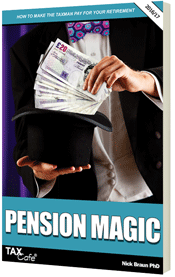Higher-Rate Tax Relief
is Here to Stay
Pension Planning: Higher-Rate Tax Relief
THERE was good new for many savers in the Budget. As we predicted last month, the Chancellor did not take away higher-rate tax relief on pension contributions. If anything, it will be extended to more people.
Higher-rate tax relief is the extra 20% tax refund you receive in respect of your pension contributions when you submit your tax return. It comes on top of the 20% basic-rate tax refund the taxman pays directly into your pension plan.
Higher-rate tax relief was due to be taken away from those earning over £150,000 from April next year. The Lib Dems wanted to go one step further and in their election manifesto proposed taking the extra 20% tax refund away from all higher-rate taxpayers, even those who only earn around £44,000.
The new Government believes that even the clamp down on those earning over £150,000 “could have unwelcome consequences for pension saving, bring significant complexity to the tax system and damage UK business and competitiveness. An alternative approach involving a significantly reduced annual allowance might better meet the Government’s objectives.”
The Government believes that reducing the annual contribution limit for everyone to somewhere in the region of £30,000 to £45,000 will raise the same amount of tax revenue as the previous attack on high earners.
An annual contribution limit of between £30,000 and £45,000 (£60,000 to £90,000 for couples, remember) is generous enough for most retirement savers and especially appealing if you know the maximum 40% tax relief will continue to be available, as seems likely.
Remember pension plans with full tax relief on contributions, tax-free investment growth and a tax-free lump sum when you retire, are arguably the most powerful tax shelters available to those saving for retirement.
If you don’t contribute to one at present you should seriously consider starting to do so now!
The tax breaks are better even than those available from ISAs (although ISAs are more flexible and shelter you from any future increase in tax rates).
There will be losers if the pension contribution rules are changed, of course. In this case the losers will be those who make annual pension contributions of more than £30,000 to £45,000 per year.
For example, there will be many executives and owners of successful businesses in their fifties or sixties who are currently earning a large taxable income but have very few financial commitments. For example, they may have little or no debt, the children may have flown the rest and now is the perfect time to make big catch-up contributions to a pension plan.
However, even this group will prefer having a limit placed on their higher-rate tax relief rather than having this relief abolished altogether.
Compulsory Pensions
There was also good news for those approaching retirement. The age at which your are forced to take an income from your pension plan was increased from 75 to 77 and this requirement will probably be abolished altogether in the very near future.









